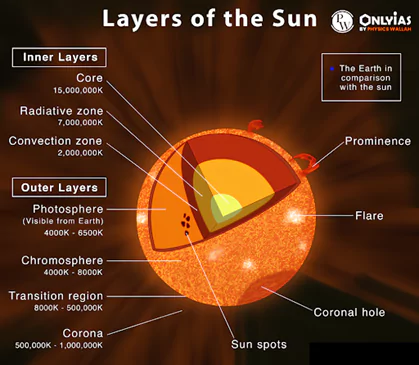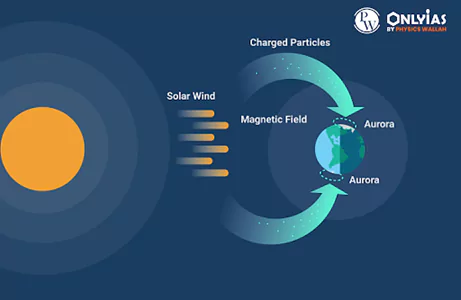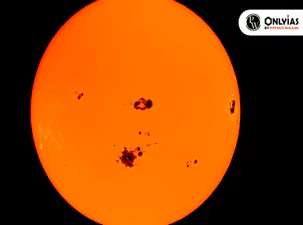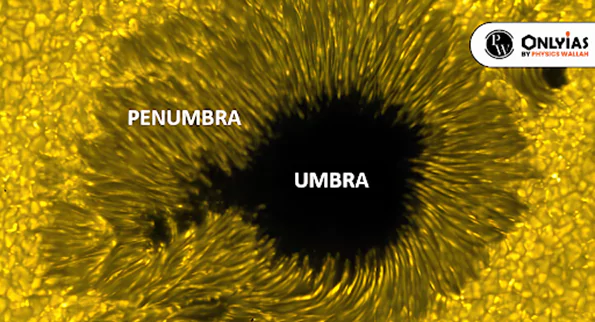Introduction to Sun
The sun is the central star of our solar system, around which earth along with other planets revolves. It is primarily composed of hot gasses.
- Age of the sun: Approximately 4.6 billion years
- Diameter: 1.39 million kilometers
- Temperature of the sun: Around 6000°C on the surface and a scorching 16 million°C in the core
- Density: 1.41 times that of water (Water’s density = 999.97 kg/m³; Earth’s overall density is 5.5 times that of water).

- Surface Gravity: 274 m/s², which is 28 times that of Earth
- Rotation Speed: Approximately 7179.73 km/hour, significantly faster than Earth’s rotational velocity of 1675 km/hour
- Period of Rotation: Completes one rotation in about 25 days and 9 hours
- Rotation Direction: Counter-clockwise when viewed from a perspective far above Earth’s north pole
- Mass of the sun: Equivalent to approximately 332,900 Earth masses
- Composition: Composed mainly of hydrogen and helium, accounting for about 98% of its mass
- Solar System Mass Dominance: Although the Sun makes up about 99.8% of the solar system’s total mass, it contributes only about 2% of the angular momentum due to its gaseous, differentially rotating structure.
Layers of Sun:
| Layers | Components | Description |
|
Inner Layers |
Core |
|
| Radiative zone |
|
|
| Convection zone |
|
|
|
Outer Cells |
Photosphere |
|
| Chromosphere |
|
|
| Corona |
|
Solar winds: The Solar Breeze that Shapes Space Weather
- Definition: They are a continuous stream of charged particles, primarily electrons and protons, that are ejected from the outermost layer of the Sun’s atmosphere, known as the solar corona, into space.
- Composition: It consists mainly of charged particles, primarily electrons and protons, with trace amounts of heavier ions and atomic nuclei.
- Origins: They are generated by the Sun’s extreme heat and magnetic activity.
- They are primarily expelled from regions on the Sun with open magnetic field lines, such as coronal holes and active regions like sunspots.
- Impact on Space Weather: They play a significant role in space weather.
- When they interact with the Earth’s magnetosphere, they can cause geomagnetic storms and disrupt satellite communications, power grids, and navigation systems.
Exploring Solar/Stellar Flares: The Sun’s Electromagnetic Fury
- About: It is a dramatic increase in the brightness of a star due to magnetic energy stored in the star’s atmosphere.
- Formation: It is often accompanied by coronal mass ejection.
- Composition: They eject clouds of electrons, charged ions and atoms with electromagnetic radiation.

- Impact of Solar/Sun’s Flare: From Polar Lights to Sterilization
-
- Polar Lights: when the sun flare hits the earth’s upper atmosphere, it excites the molecules of nitrogen and oxygen in the atmosphere.
- These excited molecules produce polar lights or aurora.
- Aurora Borealis: The interaction of sun flare and earth’s magnetic field at the North pole produces Aurora Borealis, also known as Northern lights.
- Aurora Australis: The interaction of solar flare and earth’s magnetic field at the South pole produces Aurora Australis, also known as Southern light.
- Disruption in Communication: X-rays and UV rays may affect and disrupt long-range radio communications.
- Hurdle in man space mission: Radiations due to solar flare pose one of the major hurdles for man space mission.
- Sterilization: Huge amounts of energy can strip water from the atmosphere and sterilize the ground.
- Polar Lights: when the sun flare hits the earth’s upper atmosphere, it excites the molecules of nitrogen and oxygen in the atmosphere.
Coronal Mass Ejections (CMEs): Sun’s Impact on Technology
|
Sunspots: Dark Regions and Solar/Sun Cycles
- About: They are created due to magnetic fields created over the surface because of which the region becomes darker and cooler than surroundings.
- They are regions on the Sun’s surface, known as the photosphere, that appear darker than their surroundings.
- They are not present all over the Sun’s surface, present between 25° – 30° latitude.

- Solar Cycle and Sunspots: In every solar cycle, the number of sunspots on the Sun’s surface goes through a periodic increase and decrease.
- The current solar cycle, which commenced in 2008, is presently in its ‘solar minimum’ phase.
- During this phase, the number of sunspots and solar flares on the Sun is at a relatively low and routine level.
- Characteristics:
- The number of sunspots fluctuates every 11 years due to the Sun’s magnetic activity. Thus it is known as the Sunspot cycle.
- Some sunspots can be as large as 50,000 kilometres in diameter.
- Despite appearing dark, the temperature within a sunspot remains extremely hot, at around 6,500 degrees Fahrenheit (3,600 degrees Celsius).
- The photosphere is the visible surface of the Sun and emits most of the Sun’s light directly toward Earth.
- Some Sunspots appear cooler because they form in areas where the Sun’s magnetic fields are exceptionally strong.
- The magnetic fields within sunspot areas can be approximately 2,500 times stronger than Earth’s magnetic field.
- Two Regions of Sunspots:
- Umbra: the darker central part known as the ‘umbra’.
- Penumbra: the lighter surrounding region called the ‘penumbra.’

| Attempt the Previous Year Question (Prelims)
Q. If a major solar storm (solar flares) reaches the Earth, which of the following are the possible effects on the Earth? (2022)
Select the correct answer using the code given below:
Answer: C |
Q. The increasing amount of carbon dioxide in the air is slowly raising the temperature of the atmosphere, because it absorbs (2012)
(a) the water vapour of the air and retains its heat
(b) the ultraviolet part of the solar radiation
(c) all the solar radiations
(d) the infrared part of the solar radiation
Ans: (d)






























